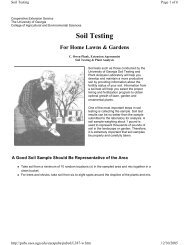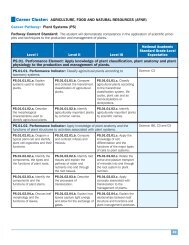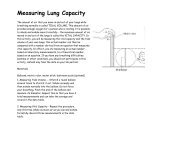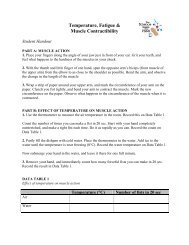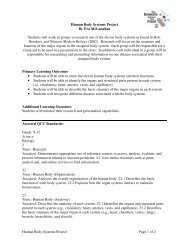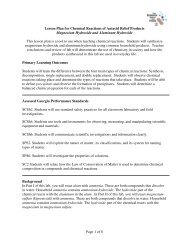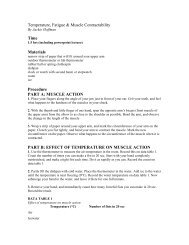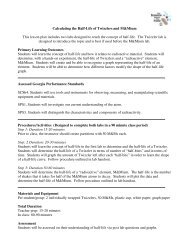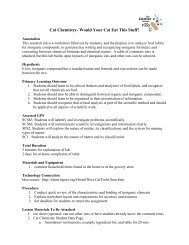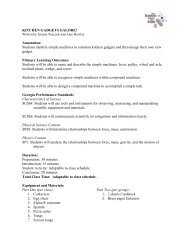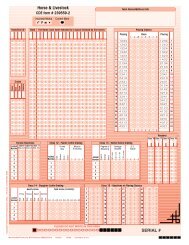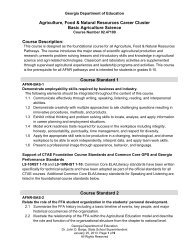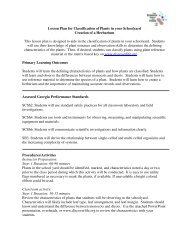Moving Fluids in Plants: Experiments with celery
Moving Fluids in Plants: Experiments with celery
Moving Fluids in Plants: Experiments with celery
- No tags were found...
You also want an ePaper? Increase the reach of your titles
YUMPU automatically turns print PDFs into web optimized ePapers that Google loves.
<strong>Mov<strong>in</strong>g</strong> <strong>Fluids</strong> <strong>in</strong> <strong>Plants</strong>: <strong>Experiments</strong> <strong>with</strong> <strong>celery</strong>AnnotationStudents will explore the vascular tissue of a <strong>celery</strong> stalk. The <strong>celery</strong> stalk serves as a model forthe generalized plant. In Part I of the activity, students will use a dye to determ<strong>in</strong>e the location ofthe vascular tissues. In Part II of the activity, they will explore how light <strong>in</strong>fluences the rate ofmovement of water <strong>in</strong> the vascular tissues.Problem: Can water travel through plant stems? Can we determ<strong>in</strong>e how a directed light source<strong>in</strong>fluences the rate at which water travels through plant stems?Background ResearchRead about the parts of a plant <strong>in</strong> a biology textbook. Especially look for xylem and phloem.Write three paragraphs about what you read. (Note: locate a specific website that has the<strong>in</strong>formation you wish to have them read, or identify a specific section of a text book or both).HypothesisBased on your research and your experience <strong>with</strong> plants, why do you th<strong>in</strong>k water can travelthrough the plant stem? In this lab there are two specific hypotheses that you are go<strong>in</strong>g to test:a. First, plant tissues which carry water up (or down) the plant stem can be dist<strong>in</strong>guishedfrom those tissues which have other purposes.b. Second, the rate of water movement <strong>in</strong> the plant’s stem will be changed as a result ofthe amount of light sh<strong>in</strong><strong>in</strong>g on the plant.Amount of time2 hoursAssessed GPSSCSh9. Students will understand important features of the process of scientific <strong>in</strong>quiry.SCSh5. Students will be able to communicate scientific ideas and activities clearly.Materials:Part I250 ml graduated cyl<strong>in</strong>der (plastic) or similar sized bottle/conta<strong>in</strong>er1 - 250 ml beakersfood color<strong>in</strong>gLaboratory knifeTap waterPart II2 - 250 ml graduated cyl<strong>in</strong>ders (plastic ) or similar sized bottle/conta<strong>in</strong>er2 – 250 ml beakers2 colors of food color<strong>in</strong>glaboratory knifetap waterlight source
MOVING FLUID IN PLANTS: EXPERIMENTS WITH CELERYPART IMaterials:250 ml graduated cyl<strong>in</strong>der (plastic) or similar sized bottle/conta<strong>in</strong>er1 - 250 ml beakersfood color<strong>in</strong>gLaboratory knifeTap waterProcedures:1. Pour 100 ml of water <strong>in</strong>to each beaker2. Add three or four drops of food color<strong>in</strong>g to each glass. There is no need to add more color<strong>in</strong>gthan four drops, but you should ensure that the color is not transparent.3. Very carefully cut bottom of the stem while the stem is submerged to ensure that the vasculartissue is open.4.. Let the stalk stand <strong>in</strong> the water for 1 hour.5. Make a cross sectional cut across the <strong>celery</strong> approximately ½ of the way up the stalk. Cut asmall section of the stalk and observe under a stereomicroscope. Make a diagram whichdist<strong>in</strong>guishes the colored tissues from those <strong>with</strong>out the food color<strong>in</strong>g. Why are some tissuescolored and others not.Data: Be sure to record your observations and <strong>in</strong>ferences.Conclusion: This is not optional. You must expla<strong>in</strong> what you learned by do<strong>in</strong>g this activity.Answer the question you were asked <strong>in</strong> the first part of the orig<strong>in</strong>al problem statement (e.g., Canwater travel through plant stems?). How does this activity provide a test of the first hypothesis?(e.g., plant tissues which carry water up (or down) the plant stem can be dist<strong>in</strong>guished from thosetissues which have other purposes). Can you make a statement as to how the water carry<strong>in</strong>gtissues are different from those which do not carry water?
MOVING FLUID IN PLANTS: EXPERIMENTS WITH CELERYPART IIMaterials:2 - 250 ml graduated cyl<strong>in</strong>ders (plastic ) or similar sized bottle/conta<strong>in</strong>er2 – 250 ml beakers2 colors of food color<strong>in</strong>glaboratory knifetap waterlight sourceProcedures:1. Pour 100 ml of water <strong>in</strong>to each beaker2. Add three or four drops of food color<strong>in</strong>g to each glass. There is no need to add more color<strong>in</strong>gthan four drops, but you should ensure that the color is not transparent.3. Very carefully cut bottom of the stem while the stem is submerged to ensure that the vasculartissue is open.4. Let one stalk stand <strong>in</strong> the water under a light source and another stalk stand <strong>in</strong> the water <strong>in</strong> thedark, for 1 hour.5. Make a cross sectional cut across the <strong>celery</strong> approximately ½ of the way up the stalk. Cut asmall section of the stalk and observe under a stereomicroscope. Make a diagram whichdist<strong>in</strong>guishes the colored tissues from those <strong>with</strong>out the food color<strong>in</strong>g. Why are some tissuescolored and others not.Data: Be sure to record your observations and <strong>in</strong>ferences.Conclusion: This is not optional. You must expla<strong>in</strong> what you learned by do<strong>in</strong>g this activity.Answer the question you were asked <strong>in</strong> the first part of the orig<strong>in</strong>al problem statement (e.g., Canwater travel through plant stems?). How does this activity provide a test of the secondhypothesis? (e.g., Is the rate of water movement <strong>in</strong> the plant’s stem changed as a result of theamount of light sh<strong>in</strong><strong>in</strong>g on the plant.). Can you make a statement as to how the water carry<strong>in</strong>gtissues are different from those which do not carry water?



